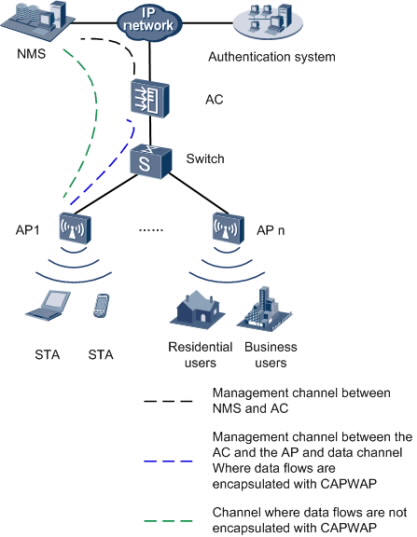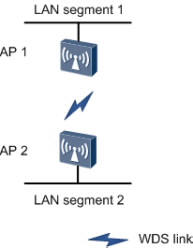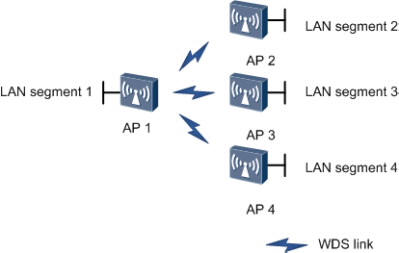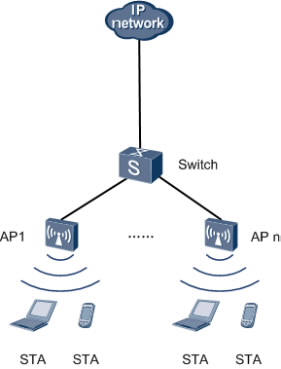Outdoor dual-frequency AP with external antennas, SFP, and AC power supply.
Compliance with IEEE 802.11a/b/g/n, providing a maximum rate of 300
Mbit/s
Maximum ratio combining (MRC)
Maximum-likelihood detection (MLD)
Data unit aggregation, including A-MPDU (Tx/Rx) and A-MSDU (Rx only)
Short GI in 20 MHz and 40 MHz modes
Priority mapping and packet scheduling based on a Wi-Fi Multimedia
(WMM) profile to implement priority-based data processing and
forwarding
Automatic and manual rate adjustment (the rate is adjusted
automatically by default)
WLAN channel management and channel rate adjustment
Automatic channel scanning and interference avoidance
Service set identifier (SSID) hiding
Signal sustain technology (SST)
Unscheduled automatic power save delivery (U-APSD)
Control and Provisioning of Wireless Access Points (CAPWAP) in Fit
AP mode
Automatic login in Fit AP mode
Wireless distribution system (WDS) in Fit AP mode
Mesh networking in Fit AP mode
Compliance with IEEE 802.3u
Auto-negotiation of the rate and duplex mode and automatic
switchover between the Media Dependent Interface (MDI) and Media
Dependent Interface Crossover (MDI-X)
SSID-based VLAN assignment
VLAN trunk on uplink Ethernet ports
4094 VLAN IDs (1-4094) and a maximum of 16 virtual APs (VAPs) for
each radio
AP control channel in tagged and untagged mode
DHCP client, obtaining IP addresses through DHCP
Tunnel data forwarding and direct data forwarding
STA isolation in the same VLAN
Access control lists (ACLs)
Link Layer Discovery Protocol (LLDP)
Uninterrupted service forwarding upon CAPWAP channel disconnection
in Fit AP mode
Unified authentication on the AC in Fit AP mode
AC dual-link backup and VRRP hot backup in Fit AP mode
Native IPv6
IPv4/IPv6 dual stack
IPv6 Portal
IPv6 SAVI
IPv4/IPv6 ACL
Priority mapping and packet scheduling based on a Wi-Fi Multimedia
(WMM) profile to implement priority-based data processing and
forwarding
WMM parameter management for each radio
WMM power saving
Priority mapping for upstream packets and flow-based mapping for
downstream packets
Queue mapping and scheduling
User-based bandwidth limiting
Adaptive bandwidth management (the system dynamically adjusts
bandwidth based on the number of users and radio environment to
improve user experience)
Open system authentication
WEP authentication/encryption
WPA/WPA2-PSK authentication and encryption
WPA/WPA2-802.1x authentication and encryption
WAPI authentication and encryption
Supports wireless intrusion detection system (WIDS), including rogue
AP and STA detection, attack detection, STA/AP blacklist and
whitelist.
Unified management and maintenance on the AC in Fit AP mode
Automatic login and configuration loading, and plug-and-play (PnP)
in Fit AP mode
WDS zero-configuration deployment in Fit AP mode
Mesh network zero-configuration deployment in Fit AP mode
Batch upgrade
Local AP management through the serial interface or using Telnet
Real-time configuration monitoring and fast fault location using the
NMS
System status alarm
Identifies the device type according to the organizationally unique
identifier (OUI) in the MAC address.
Identifies the device type according to the user agent (UA)
information in an HTTP packet.
Identifies the device type according to DHCP options.
The RADIUS server delivers packet forwarding, security, and QoS
policies according to the device type carried in the RADIUS
authentication and accounting packets.
Locates tags manufactured by AeroScout or Ekahau.
Locates Wi-Fi terminals.
Identifies interference sources such as bluetooth devices, microwave
ovens, cordless phones, ZigBees, game controllers, 2.4 GHz/5 GHz
wireless video and audio devices, and baby monitors.
Works with eSight to locate and perform spectrum analysis on
interference sources.
|
Item
|
Description
|
|
|
Technical specifications |
Dimensions (H×W×D) |
83 mm×255 mm×255 mm |
|
Weight |
2.65 kg |
|
|
System memory |
128 MB DDR2 |
|
|
Power specifications |
Power input |
AC input voltage |
|
Maximum power consumption |
30 W |
|
|
Environment parameters |
Operating temperature |
-40℃
to +60℃ |
|
Storage temperature |
-40℃
to +70℃ |
|
|
Humidity |
0% to 100% (non-condensing) |
|
|
Waterproof grade |
IP67 |
|
|
Altitude |
–60 m to 4000 m |
|
|
Item
|
Description
|
|||
|
Antenna type |
Dual-polarization antenna or common outdoor antenna |
|||
|
Maximum number of concurrent users
|
128 |
|||
|
Maximum transmit power |
2.4G: 27dBm |
|||
|
Maximum |
2.4 GHz |
5 GHz |
||
|
NOTE:The number of non-overlapping channels allowed varies
in different countries. For details, see the Country codes &
Channels compliance status |
||||
|
Channel Rate |
802.11b: 1, 2, 5.5, and 11 Mbit/s |
|||
|
802.11g: 6, 9, 12, 18, 24, 36, 48, and 54 Mbit/s |
||||
|
802.11n data rate (2.4 GHz and 5 GHz) |
||||
|
GI2=800ns |
GI=400ns |
|||
|
20 MHz (Mbit/s) |
40 MHz (Mbit/s) |
20 MHz (Mbit/s) |
40 MHz (Mbit/s) |
|
|
6.5 @ MCS10 |
13.5 @ MCS0 |
7.2 @ MCS0 |
15 @ MCS0 |
|
|
13 @ MCS1 |
27 @ MCS1 |
14.4 @ MCS1 |
30 @ MCS1 |
|
|
19.5 @ MCS2 |
40.5 @ MCS2 |
21.7 @ MCS2 |
45 @ MCS2 |
|
|
26 @ MCS3 |
54 @ MCS3 |
28.9 @ MCS3 |
60 @ MCS3 |
|
|
39 @ MCS4 |
81 @ MCS4 |
43.3 @ MCS4 |
90 @ MCS4 |
|
|
52 @ MCS5 |
108 @ MCS5 |
57.8 @ MCS5 |
120 @ MCS5 |
|
|
58.5 @ MCS6 |
121.5 @ MCS6 |
65 @ MCS6 |
135 @ MCS6 |
|
|
65 @ MCS7 |
135 @ MCS7 |
72.2 @ MCS7 |
150 @ MCS7 |
|
|
13 @ MCS8 |
27 @ MCS8 |
14.4 @ MCS8 |
30 @ MCS8 |
|
|
26 @ MCS9 |
54 @ MCS9 |
28.9 @ MCS9 |
60 @ MCS9 |
|
|
39 @ MCS10 |
81 @ MCS10 |
43.3 @ MCS10 |
90 @ MCS10 |
|
|
52 @ MCS11 |
108 @ MCS11 |
57.8 @ MCS11 |
120 @ MCS11 |
|
|
78 @ MCS12 |
162 @ MCS12 |
86.7 @ MCS12 |
180 @ MCS12 |
|
|
104 @ MCS13 |
216 @ MCS13 |
115.6 @ MCS13 |
240 @ MCS13 |
|
|
117 @ MCS14 |
243 @ MCS14 |
130 @ MCS14 |
270 @ MCS14 |
|
|
130 @ MCS15 |
270 @ MCS15 |
144.4 @ MCS15 |
300 @ MCS15 |
|
|
NOTE:Modulation coding scheme (MCS) index: determines the
spatial flow quantity, modulation, coding rate, and data
rate. |
||||
|
Receiver |
2.4 GHz |
2.4 GHz |
2.4 GHz |
2.4 GHz |
|
5 GHz |
5 GHz |
5 GHz |
||
For more details, please refer to
For more details, please refer to AP6610DN-AGN Access Point Datasheet (PDF).
The AP is applicable to open outdoor areas with high user
densities, such as squares, residential communities, schools, and
gardens, or outdoor places that have high demands for wireless
access, such as pedestrian malls. This AP can be used together with
outdoor antenna to provide long-distance network coverage and
implements stable radio backhaul in a wireless distribution system.
The AP6610DN-AGN can work as a Fat AP or Fit AP and switch flexibly
between the two working modes based on the network plan.
When the wireless network scale is small, customers need to purchase
only AP products and set the APs to work as Fat APs. As the network
scale expands, tens of or hundreds of APs exist on the network. To
simplify network management, customers are advised to purchase ACs
to perform centralized management on the APs and set the APs to work
as Fit APs.

In this networking, the AP functions as a fit AP and provides only data forwarding functions. The AC is responsible for user access, AP go-online, AP management, authentication, routing, security, and QoS.


In this networking, the AP connects two or more independently wired or wireless LANs through wireless links to construct a network on which users can exchange data. In Wireless Distribution System (WDS) mode, the AP supports point-to-point (P2P) and point-to-multipoint (P2MP) networking modes. With 5 GHz and 2.4 GHz frequency bands, the AP can implement wireless bridging and access functions.

On the preceding network, APs function as mesh points (MPs) and are fully-meshed to establish an auto-configured and self-healing wireless mesh network (WMN). APs with the gateway function can work as the mesh portal points (MPPs) through which the WMN can provide access to the Internet. Terminals connect to APs to access the WMN. The WMN uses dedicated mesh routing protocols to guarantee high transmission quality and is more applicable to scenarios that require high bandwidth and highly stable Internet connections.

On the preceding network, the device functions as a Fat AP to implement functions such as user access, authentication, data security, service forwarding, and QoS.